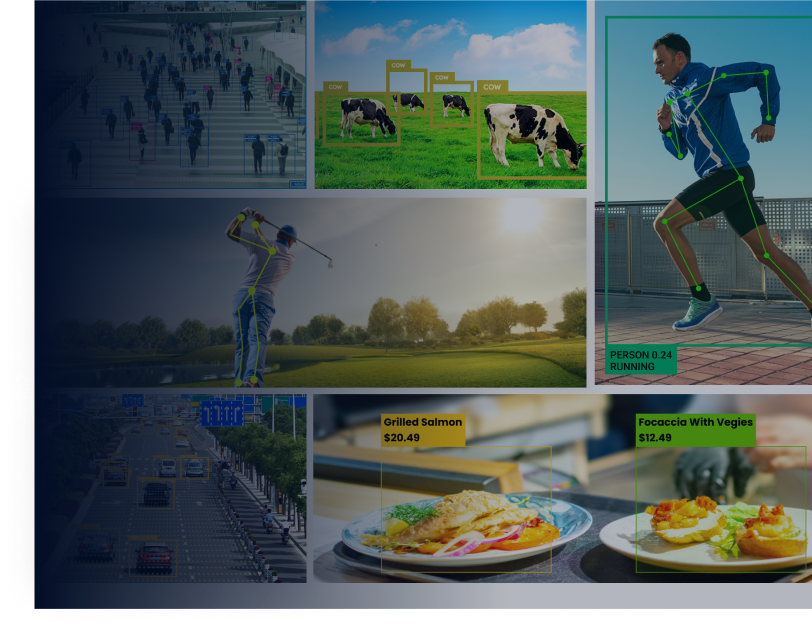AI agents have become ubiquitous in our daily lives, quietly influencing everything from the recommendations we see on social media to the products we purchase. The global AI market is expected to reach $267 billion by 2027, with AI agents playing a big role because of their ability to automate tasks, improve customer service, and boost productivity across different industries.
What exactly is an AI agent? Simply put, an AI agent is a software program that can perform tasks independently, using machine learning and natural language processing technologies. This allows it to interact smartly with users and systems, making decisions and taking actions without needing constant human input.
Some developers, tech enthusiasts, and businesses have started creating AI agents to handle routine tasks, streamline workflows, and boost productivity by automating repetitive processes. Keep reading if you’re interested in learning what an AI agent is and how to create one.
Why Are We Even Building an AI Agent?
AI agents stand out for their proactive approach and decision-making abilities. Unlike static tools, they engage actively with their environment, making choices and executing actions to meet their objectives.
Their learning and adaptation capabilities, powered by technologies like machine learning algorithms, allow them to improve and become more effective over time.It works and executes any issue just like humans do, but we need to train and design it for the specific problem we want it to solve.
Consider a scenario with Maria, a project manager, using an AI agent. Maria’s AI assistant tracks her project deadlines and team communications. When a new task is assigned, the AI agent updates the project management software, sends reminders to team members, and suggests adjustments based on current progress.
If a team member has a question, the AI agent can provide instant answers based on previously gathered data and documentation. This allows Maria to oversee the project’s strategic aspects while the AI handles routine updates and coordination.
In some cases involving multiple AI agents is also needed, such as large-scale data analysis projects, each agent may have specialized roles. For example, one agent might handle data collection, another might analyze trends, and a third might generate reports.
This collaborative approach allows for a more comprehensive and efficient problem-solving process, with each agent contributing unique expertise. In short, they simplify work and empower individuals to focus on higher-value work.
Are AI Agents Boosting Productivity?
AI agents are renowned for rationalizing processes and cultivating a more productive work environment. Automating mundane tasks empowers human workers to focus on strategic initiatives that drive innovation and growth.
The precision and consistency of AI agents significantly reduce errors and minimize the need for excessive oversight.
Their ability to analyze data rapidly provides valuable insights that inform decision-making and enable organizations to adapt swiftly to changing market conditions. Moreover, AI agents operate tirelessly, ensuring timely task completion and high service levels.
They are indispensable in creating a more efficient and effective operational landscape.
Businesses using AI chatbots have reported a 30% reduction in customer service costs and a 70% improvement in response times. In manufacturing, AI-driven automation has increased production efficiency by 25% and reduced operational costs by 20%.
There’s much more. So, there is no doubt that AI agents are boosting productivity in the workplace.
How Do We Build an AI Agent: Key Steps
1. Knowing the Problem and Objectives
To start building an AI agent, first understand the specific problem it will address and the objectives it needs to achieve. Begin by defining the problem clearly. For example, if you’re developing an AI tool for HR, the problem might be managing employee data more efficiently.
Consider the context in which the agent will operate, including any constraints or user requirements. Gather and organize necessary data, like employee records or workflow patterns.
Set clear, measurable objectives—such as reducing processing time by 40% or increasing data entry accuracy by 25%. Prioritize these goals to allocate resources effectively and ensure the AI agent meets the established success criteria.
2. Choose the Right AI Model
With a clear understanding of the problem and objectives, select an appropriate AI model. A rule-based system may suffice if the task involves automating routine customer inquiries, as it uses predefined rules for straightforward problems.
For more complex tasks, such as image recognition or natural language processing, deep learning deep learning (DL) models are more suitable. DL models use neural networks to handle intricate data and provide high accuracy, though they require more computational resources.
If the AI agent needs to learn and adapt to new data, machine learning or DL models are preferable over rule-based systems. Align the model choice with the problem’s complexity, data needs, and performance requirements.
3. Data Collection and Preparation
The success of your AI agent relies heavily on data quality. Gather relevant, comprehensive, and unbiased data from diverse sources. Structured data, such as organized databases, is straightforward to use, while unstructured data, like chat transcripts or social media posts, requires additional processing.
Clean and prepare the data by correcting errors, filling in missing information, and ensuring consistency. Data labeling is crucial for supervised learning, where accurate tagging guides the model’s training.
Regularly update the datasets to keep the AI agent relevant and incorporate feedback mechanisms to enable continuous learning and improvement.
4. Model Training and Testing
Once you have your data, proceed with model training. Start with data preprocessing, which includes steps like scaling features and reducing dimensions. Perform hyperparameter tuning to optimize the model’s performance by adjusting settings such as learning rate.
Split the data into training and validation sets to monitor the model’s learning and avoid overfitting. Regularization techniques like dropout are applied to prevent the model from becoming too complex.
For testing and validation, evaluate the model with a separate test set to ensure it performs well in real-world conditions.
Use **evaluation metrics** like accuracy or mean squared error to measure effectiveness. Based on test results, iterate and improve the model by analyzing errors, enhancing data, or using ensemble methods to boost performance.
5. Integration and Deployment
Integrating and deploying your AI agent involves several steps to ensure it functions correctly within its target environment. Define how the AI agent will fit into its environment, such as a web or mobile application.
Develop necessary interfaces, like APIs or microservices, to facilitate smooth communication. Ensure data compatibility and implement any needed data transformations. Test the integration thoroughly to identify and fix issues.
For deployment, set up the required infrastructure, including computing resources, storage and networking, focusing on scalability, availability, and security. Implement strong security measures, such as authentication and encryption, and configure the AI agent according to the deployment environment’s needs.
Provide clear user documentation and ensure continuous monitoring and maintenance to optimize performance.
6. Monitoring and Maintenance
After deploying your AI agent, focus on monitoring and maintenance to keep it effective. Set Key Performance Indicators (KPIs) like accuracy and user satisfaction, and use real-time tools to track these metrics and fix issues quickly. Collect user feedback to identify areas for improvement.
Regularly update the data and retrain the model to stay current with new trends. Use version control and A/B testing to manage and choose the best model versions. Create a feedback loop to help the AI agent learn and improve continuously.
Keep detailed records, collaborate with your team, and ensure ethical compliance. Provide ongoing user support and plan for scalability to handle increased demand. These steps will help maintain your AI agent’s performance and value over time.
Tools and Platforms You Can Use for Building AI Agents
Choosing the right platform is key to developing effective AI agents. Here’s a quick look at some popular options.
-
AI Development Platforms
- TensorFlow: Created by Google, TensorFlow is an open-source library for machine learning and deep learning. It’s versatile and scalable, making it great for both research and production, but it can be complex for beginners.
- PyTorch: Developed by Facebook, PyTorch is another open-source library known for its ease of use and flexibility. It’s ideal for research due to its dynamic computation graph, which simplifies debugging and experimentation.
- OpenAI: OpenAI offers powerful language models through APIs, making it easy to integrate advanced AI capabilities into your apps. It’s user-friendly and requires minimal setup.
- Vertex AI: A Google Cloud product, Vertex AI provides a suite of tools for building and deploying machine learning models. It includes no-code options, which make it accessible for non-technical users, and integrates well with other Google Cloud services.
- AutoGen: Developed by Microsoft, AutoGen is designed for creating conversational AI agents using large language models (LLMs). It simplifies the development of multi-turn conversations and complex tasks.
Comparison of Platform Features and Ease of Use
| Platform | Key Features | Ease of Use |
|---|---|---|
| TensorFlow | Flexible, scalable, strong community support | Moderate (steeper learning curve) |
| PyTorch | Dynamic computation graph, research-friendly | High (intuitive for experimentation) |
| OpenAI | Powerful language APIs | Very high (minimal setup needed) |
| Vertex AI | Helen Bennett | UK |
| Laughing Bacchus Winecellars | No-code options, strong integration | High (user-friendly interface) |
| AutoGen | Conversational AI, LLM support | High (no-code options available) |
-
Pre-built AI Frameworks
Pre-built frameworks can make developing AI agents easier by providing ready-to-use components.
- Dialogflow: Developed by Google, Dialogflow helps build conversational interfaces like chatbots and voice assistants. It uses natural language processing (NLP) and offers customization options for responses and functionalities.
- Rasa: An open-source framework, Rasa is designed for building contextual AI assistants. It provides tools for natural language understanding (NLU) and dialogue management, allowing for high customization to fit specific business needs.
-
Cloud Services for AI Agents
Cloud services are excellent for hosting and scaling AI agents. They offer.
- Scalability: Platforms like AWS, Azure AI, and Google Cloud AI provide scalable infrastructure to handle varying workloads without heavy upfront investments.
- Cost-Effectiveness: Many cloud services use a pay-as-you-go model, which helps manage costs effectively—ideal for startups and smaller businesses.
- Accessibility: Cloud solutions allow access from anywhere, making it easier for teams to collaborate and work remotely.
- Rapid Deployment: Cloud platforms streamline the deployment process, helping you get your AI agents to market faster.
- Integrated Services: Cloud providers offer additional services like data storage, analytics, and machine learning tools, simplifying development and management.
Organizations can build, deploy, and scale AI agents effectively to meet their specific needs by choosing the right development platform, using pre-built frameworks, and leveraging cloud services.
Build Your AI Agent With Folio3AI
Folio3 AI specializes in building AI agents that revamp business processes. With over 15 years of experience in AI development, encompassing computer vision, natural language processing (NLP), large language models (LLMs), and generative AI, we provide bespoke AI solutions tailored to meet your unique requirements.
Whether you seek to automate tasks, streamline operations, or enhance decision-making, we deliver efficient, high-impact results. Our team excels in creating both pre-built models and fully customized systems designed to improve productivity and optimize workflows.
At Folio3 AI, we focus on delivering solutions that foster growth and increase operational efficiency.
Through our rapid prototyping capabilities, we can bring your AI agent from concept to deployment within weeks. Our comprehensive development process ensures your AI agents are fully equipped to automate repetitive tasks and improve business performance. By partnering with us, you can access fast-track AI solutions that drive innovation and scale within your organization.
Wrapping up
So, here’s the deal with building an AI agent: Start by really understanding the problem you want to solve. Pick the right tools and make sure to train your model well. AI agents are fantastic at automating tasks and making decisions, which can seriously boost productivity.
Using platforms like TensorFlow, PyTorch, or OpenAI can simplify things, and pre-built frameworks and cloud services make it even easier to scale your solutions. As AI keeps advancing, these agents will keep finding new ways to tackle challenges and improve efficiency. Embracing these technologies can help your organization grow and succeed.

Dawood is a digital marketing pro and AI/ML enthusiast. His blogs on Folio3 AI are a blend of marketing and tech brilliance. Dawood’s knack for making AI engaging for users sets his content apart, offering a unique and insightful take on the dynamic intersection of marketing and cutting-edge technology.









